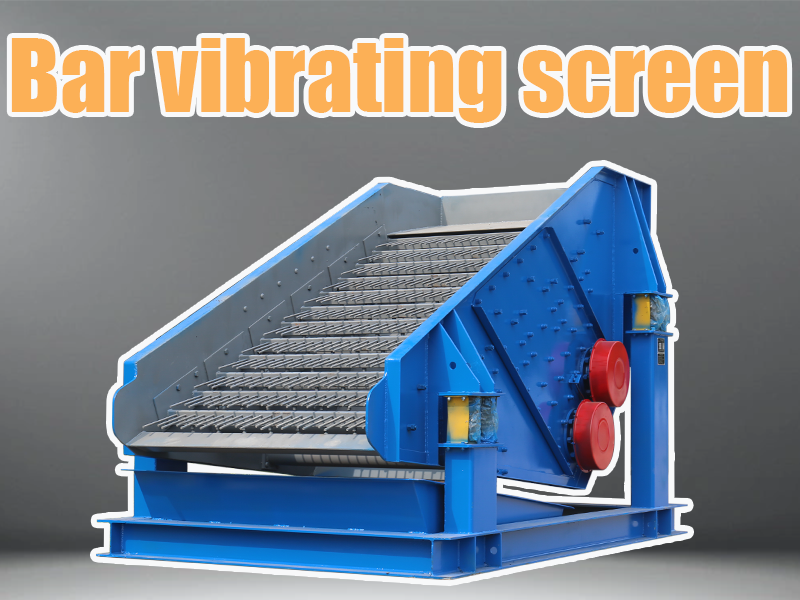Limestone is one of the most widely used materials in construction, cement production, metallurgy, and chemical industries. With its vast industrial applications and naturally abrasive nature, efficient processing and screening of limestone are essential to ensure product consistency, equipment longevity, and plant productivity. In the crushing and pre-screening stages of limestone processing, the bar vibrating screen—also known as the grizzly screen—has proven itself to be one of the most reliable and cost-effective solutions.

- Understanding the Bar Vibrating Screen: Design and Working Principle
The bar vibrating screen consists of heavy-duty steel grizzly bars mounted in parallel across a vibrating frame. Unlike conventional mesh screens, the bar screen operates without fine apertures, instead using fixed bar spacing (usually 50–150 mm) to allow undersized material to fall through while larger lumps travel across the top and are fed to crushers.
Working mechanism:
- Vibration is induced by a pair of electric motors or an exciter system.
- The screen is mounted at an inclined angle (15–25°) to allow gravity-assisted flow.
- Finer materials fall between the bars, while oversized limestone lumps are separated and sent downstream.
In limestone processing, the bar vibrating screen is typically placed before primary crushers to:
- Remove soil and small rocks (<80 mm)
- Prevent overloading of crushers
- Extend crusher life by eliminating unnecessary fines
- Why Limestone Needs a Specialized Screening Solution
Limestone presents unique challenges:
- High moisture content, particularly in freshly quarried or rainy regions
- Irregular shape and hardness variability depending on source (e.g., dolomitic vs. chalk limestone)
- Potential for clogging screens with mesh or perforated plates
- High volumes required for cement and road base aggregate production
The bar vibrating screen addresses these challenges with its open deck structure and self-cleaning motion, making it an ideal match for high-throughput limestone operations.
- Advantages of Using a Bar Vibrating Screen for Limestone
A. Superior Wear Resistance for Abrasive Material
Limestone, especially when dry and angular, can be abrasive. The bar vibrating screen is built using wear-resistant alloy steel (often high-manganese or chromium steel), with optional rubber or polyurethane liners at impact points. This enhances durability and reduces downtime in high-load conditions.
B. Self-Cleaning and Non-Clogging Performance
Unlike mesh or plate screens, the wide spacing and simple structure of the bar screen prevent clogging, even in damp or clay-contaminated limestone. The vibration force continuously clears the bar gaps of stuck particles, maintaining consistent screening performance.
C. High Screening Capacity
Bar vibrating screens can handle significant feed volumes. A typical configuration with a 1500 mm × 4000 mm deck can process between 400 and 800 tons per hour of limestone. Larger configurations (e.g., 2000 mm × 6000 mm) used in cement production lines can achieve outputs exceeding 1000 tons/hour.
D. Cost-Effective Crusher Protection
The grizzly screen removes fines and non-crushable material (e.g., clay, wet soil, or debris), preventing jaw or impact crushers from experiencing wear and blockages. This leads to:
- Reduced energy consumption at the crusher
- Increased throughput consistency
- Lower wear part replacement frequency
E. Low Maintenance, Long Service Life
With few moving parts and no mesh to replace, the bar vibrating screen requires minimal maintenance. Routine checks on bar alignment and motor lubrication are typically sufficient. When bars wear out, they can be individually replaced without removing the whole deck.
- Output Performance and Technical Specifications
Here’s a reference guide for production capacity and technical parameters when screening limestone:
Model: 1500 mm × 4000 mm bar vibrating screen
- Feed size: Up to 900 mm limestone blocks
- Bar spacing: 80 mm (customizable between 50–120 mm)
- Screening capacity: 600–750 tons/hour
- Installed power: 2 × 11 kW vibration motors
- Vibration amplitude: 4–6 mm adjustable
- Vibration frequency: 960–980 RPM
These specs may vary based on material moisture, particle shape, and feeder setup.

